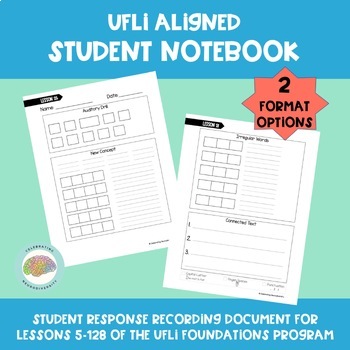Student notebook- sheets for written responses that aligns with UFLI 5-128
- Zip
What educators are saying
Description
*Please note: These files are an independent product and are not affiliated with, nor have they been authorized, sponsored, or otherwise approved by UFLI Foundations.
These sheets provide an area for written responses for lessons 5-128 in the UFLI Foundations manual. Say goodbye to scattered paper and teaching materials and hello to a structured, efficient learning environment! It includes handwriting practice, Elkonin boxes, sentence writing reminders, and scaffolding options all in one place. Print this “notebook” with the lessons from UFLI you plan to teach and you are ready to go!
WINNING!!!
⭐️ Students’ work is all in one place
⭐️ stay organized
⭐️ easy to monitor students’ progress
⭐️ easy and fast option to provide corrective feedback
⭐️ consistent layout and routine throughout to increase engagement and learning
⭐️ NO PREP once printed
What you get:
2 formats for the lessons and 3 printing options. Each format includes 272 pages.
4 Cover options
Bonus: 16 additional generic lesson forms and 9 progress monitoring format options are now included!
Please see the preview and details below
Auditory Drill: Space is provided for students to write the letter or letter combinations that are orally presented by the teacher. The number and size of boxes are based on the auditory drill for each UFLI lesson.
New Concept: This area provides space to practice grapheme-phoneme correspondences explicitly and systematically. The sheet provides handwriting lines to help with letter formation practice being introduced in the lesson.
The sheet provides an area to spell words with the phoneme-grapheme correspondence being taught. The area is provided for the “I do” and “We do” portions of the lesson. One format includes Elkonin boxes, providing more scaffolding to help guide the students in segmenting the words into phonemes. Shaded boxes and outlined boxes are used to draw attention to multi-syllabic words and affixes. Both sheets include handwriting lines for more letter formation practice.
Irregular Words: This area is provided to help students spell irregular words.
One format includes Elkonin boxes, providing more scaffolding to help guide the students in segmenting the words into phonemes. This segmentation enhances students’ orthographic mapping by looking at regular and irregular parts within each word. The number of Elkonin boxes is based on the number of phonemes in each irregular word being reviewed and taught in each lesson. A more generalized word mapping format begins in lesson 66.
Both sheets include lines for writing irregular words and space for hearts and boxes.
One format is more general in the number of lines provided and no Elkonin boxes are provided. This format can be used if you are working individually or with small groups who are working on words other than the ones specified in each lesson.
Connected Text: This step enforces generalization of skills taught and reviewed through writing dictated sentences. For more scaffolding, you can draw a line for each word to be placed.
Both formats provide lines for students to write the dictated sentences provided in each lesson.
A visual is provided to encourage self-monitoring while writing. The mnemonic CAPS is used in lessons 35-128. A simpler and more visual self-monitoring reminder is placed at the bottom of lessons 5-34. This includes a reminder for capitalization, finger space between words, and punctuation at the end.
Ways to Assemble
✏️ bind the pages together to make a book
✏️ split lessons into chunks and staple together
✏️ use individual pages
*One lesson is 2 pages. I print double sided to save paper and size.
Not sure how to map each word. Use phoneme-grapheme mapping generator here: Phonics + Stuff
-Please note: These files are an independent product and are not affiliated with, nor have they been authorized, sponsored, or otherwise approved by UFLI Foundations.
Looking for more? I have games and other materials that align with UFLI!
Reading CVC Words Game-aligns with Lesson 19 in UFLI
Sounds of Letter S: Goes great with Lessons 20-21 in UFLI
Short Vowel Card Game Bundle -6 Games to review all short vowels
Top 5 Reasons why you Should Incorporate Games with Reading Instruction
Questions?
Please contact me at erin@celebratingneurodiversity.com or send me a question via Q/A.
Leaving Feedback
I would love your feedback! I strive to make products that are fun and help children learn. If you have any questions or concerns, please contact me before rating. Thanks so much!
Let’s Connect
Thanks for stopping in my store!
Erin Giles- Celebrating Neurodiversity





